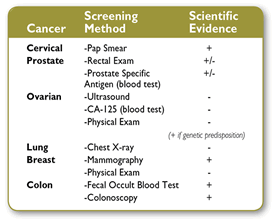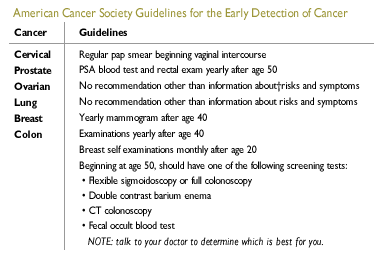Cancer Screening — Tools for Early Detection
Richard Daniels, MD, FACS
General Surgery
Evergreen Surgical
Eau Claire
Cancer screening has become increasingly important as new and more sophisticated methods have been introduced into the practice of medicine. Screening is a theoretically based practice of finding cancer in individuals who are without symptoms. The perception is that the earlier the diagnosis of cancer the better, and the hope is that screening will reduce cancer related deaths. Based on the evidence the perceptions and hopes may not always be correct. This article is an attempt to review and summarize the current evidence for screening common cancers.
The screening test for cancer in individuals must have certain requirements. First, the tests should be both accurate and reproducible. Secondly, there has to be an effective treatment for the cancer being screened. Finally, the cancer being screened must be a cancer that affects a large population and has serious consequences (rapid loss of quality of life and/or death) that can justify the risks of screening methods. These risks include false positives, radiation exposure, over diagnosis (the diagnosis of a condition or disease more often than it is actually present), and increased health care costs. The benefits of screening include reducing both mortality and treatments such as decreased surgery and chemotherapy.
“Some common cancers that screening tests are used for include cervical, prostate, ovarian, lung, breast and colon.”
The table below summarizes the screening method for these cancers and indicates whether scientific studies show benefits from the screening methods:

What the scientific studies show and what is currently recommended today for cancer screening is different. These differences exist for a variety of reasons such as: a lack of good non-biased scientific studies, emotional factors associated with the fear of cancer, and assumptions made by both physicians and patients. For example:
The U.S. Preventative Services Task Force (USPSTF) recently recommended changing the current guidelines for mammography and self breast exams in women. These changes were recommended based on the results of two large studies commissioned by the task force. The recommendations by the USPSTF drew mixed reactions from physicians, medical organizations, federal health officials and most passionately by breast cancer patients and breast cancer survivors.
To help clarify screening methods the American Cancer Society studies the methods and annually gives recommendations for screening. These recommendations may change in the future as newer diagnostic methods based on molecular technology emerge. I believe these current recommendations are the best. These screening recommendations are summarized in the following table.

In summary, it is my belief that good communication with patients and their health care provider is still the best pre-screening tool we have. Be proactive with your health-care by discussing screening options with your physician and when the appropriate time may be for your screening especially when there is a genetic predisposition for cancer (i.e. family history). Let us all share the common goal of lowering the mortality associated with cancer by having a good understanding of who and when to screen.
Dr. Daniels – Evergreen Surgical
For information or to schedule an appointment:
715.832.1044 | evergreensurgical.com
Dr. Daniels sees patients in Eau Claire and Chippewa Falls.





 © 2009 OakLeaf Medical Network and OakLeaf Surgical Hospital. All rights reserved.
© 2009 OakLeaf Medical Network and OakLeaf Surgical Hospital. All rights reserved.